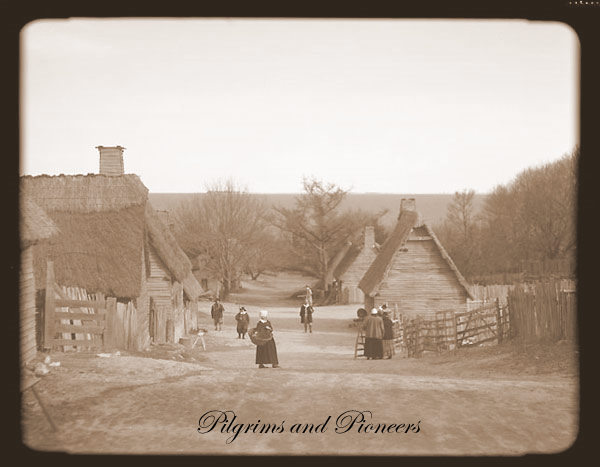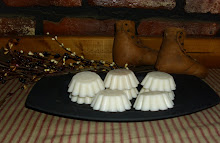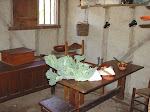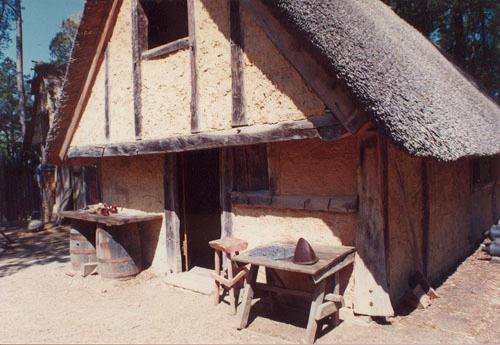Soon I will be moving to the pioneer relatives of mine but I thought you might find this tidbit about prairie bonnets interesting in the meantime.
Prairie bonnets were a staple in the pioneer woman's wardrobe.
The sun on the prairie as they traveled it could be unrelenting so the bonnets were made with extra wide brims to help shield their faces from the sun. The bonnets were also made with a very long pleated "apron" to keep the back of the neck form becoming sunburned.
I was so fascinated with my gggrandmother Sarah Jones Dow being a pioneer woman that I searched until I found an authentic bonnet pattern and quickly set about making some!
They are a great primitive/colonial decorating accent!
You can order here http://www/pilgrimsandpioneersprimitves.blogspot.com
Welcome To Pilgrims and Pioneers!
After many years of researching my family geneaology I have been lucky enough to discover actual information about my relatives that lived in the Pilgrim Era and the Pioneer Era- while many people also have realtives from those eras- many do not know their names or where they lived- actually seeing the proof in print makes you much more aware of who they really were.
After discovering these relatives it of course made me curious to learn more about the eras that they lived in and what their lives were like as, the history I learned in grade school had long since been forgotten.
I decided to start this blog for others who are also interested in these eras.
Some of the information here will be actual facts about my realtives and some will be information about the eras in general that I have found on the web.
I hope you will enjoy traveling back in time with me!
After discovering these relatives it of course made me curious to learn more about the eras that they lived in and what their lives were like as, the history I learned in grade school had long since been forgotten.
I decided to start this blog for others who are also interested in these eras.
Some of the information here will be actual facts about my realtives and some will be information about the eras in general that I have found on the web.
I hope you will enjoy traveling back in time with me!
Thursday, February 28, 2008
From then until Now
I have decided that I should tell you just how I am connected to Eduaod Bompasse -that so long ago came to America and Plimoth Colony. I will list my ancestors according to the information that I have at this time:
Eduaod & Hannah Bompasse
John & Sarah Hunter Bumpass
Edward & Martha Rayment ( Raymond) Bumpass
Edward & Mariah Benson Bumpass
Edward & Jerusha Wheat Bumpass
Edward & Betsey Lawrence Bump
Eunice Bump & Whitcher Dow
Benjamin & Sarah Jones Dow
Zilla Dow & William Shere
Atrhur Pierceson & Temple Shere Pierceson
Glenn & Fern King Pierceson ( My Parents)
The last generation is my son Michael Wiemken
Note: I am absolutely fascinated by some of the names of my ggrandmothers! Let me know if you find them fascinating too!
Eduaod & Hannah Bompasse
John & Sarah Hunter Bumpass
Edward & Martha Rayment ( Raymond) Bumpass
Edward & Mariah Benson Bumpass
Edward & Jerusha Wheat Bumpass
Edward & Betsey Lawrence Bump
Eunice Bump & Whitcher Dow
Benjamin & Sarah Jones Dow
Zilla Dow & William Shere
Atrhur Pierceson & Temple Shere Pierceson
Glenn & Fern King Pierceson ( My Parents)
The last generation is my son Michael Wiemken
Note: I am absolutely fascinated by some of the names of my ggrandmothers! Let me know if you find them fascinating too!
Tuesday, February 26, 2008
Early Fabric Dyeing
Ever wonder how the old fabrics got their color back then? No rit dye in those times!
Indigo was used for blue
Madder for red
Butternut husks or summach blossoms were used for browns
Onion skins, waxwood or goldenrod were used for yellow
Beech tree bark was used for drab
Green was created by first steeping in yellow dye followed by steeping in blue dye
Although they were able to dye their fabrics this way it was very difficult for them to duplicate these colors each and every time.
Indigo was used for blue
Madder for red
Butternut husks or summach blossoms were used for browns
Onion skins, waxwood or goldenrod were used for yellow
Beech tree bark was used for drab
Green was created by first steeping in yellow dye followed by steeping in blue dye
Although they were able to dye their fabrics this way it was very difficult for them to duplicate these colors each and every time.
Colony Door Mats
The early door mats were made of a material called "corn sheathing"- the fine husks that enveloped Indian Corn.
The husks were first braided into a thick rope and sewn into a round or oval mat,
Before twine was plentiful for such sewing, the tough inner bark of the cedar tree was used, or a single blade of the husk threaded through the large eye of a wooden needle.
The husks were first braided into a thick rope and sewn into a round or oval mat,
Before twine was plentiful for such sewing, the tough inner bark of the cedar tree was used, or a single blade of the husk threaded through the large eye of a wooden needle.
Monday, February 25, 2008
Making Tallow Candles
Being a modern day soy candle maker I was curious as to how tallow candles had been made.
I searched the web and found some basic instructions. If you decide you are going to try to make your own candles I would recommend doing your own research first to completely understand the process and the possible risks that go with it- and I have heard that actual burning tallow candles are actually not always pleasant smelling.
The basic instructions are as follows:
Using beef suet cut the suet up into small chunks and place in a large pot filled with enough water to cover the suet. Add 1 tbsp. of salt per pound of suet. Boil this until only the fat remains- this has to be strained to remove any bits of meat that has come out of the suet. The strained liquid is the fat you use to make the actual candles with.
Dip the wick material- they used cotton twine- to thoroughly saturate the wick. After that the dipping process needs to be much faster and the tallow must be kept on low warm ot the fat will be too hot to stick to the wick material. After each dip into the tallow you must dip into a cold water bath to start hardening and forming the candle. This being said you must keep drying off the candle to prevent water from becoming trapped inside the candle as the water will cause the candle to sputter when burning. The result is an uneven shaped nubby candle being wider at the bottom.
I think I were actually ever to try candle dipping I would use beeswax like the more affluent colonists did to avoid the smell.
The article also stated that this is a very messy process that will likely get melted suet all over your kitchen so I would be armed with plenty of newspapers!
I searched the web and found some basic instructions. If you decide you are going to try to make your own candles I would recommend doing your own research first to completely understand the process and the possible risks that go with it- and I have heard that actual burning tallow candles are actually not always pleasant smelling.
The basic instructions are as follows:
Using beef suet cut the suet up into small chunks and place in a large pot filled with enough water to cover the suet. Add 1 tbsp. of salt per pound of suet. Boil this until only the fat remains- this has to be strained to remove any bits of meat that has come out of the suet. The strained liquid is the fat you use to make the actual candles with.
Dip the wick material- they used cotton twine- to thoroughly saturate the wick. After that the dipping process needs to be much faster and the tallow must be kept on low warm ot the fat will be too hot to stick to the wick material. After each dip into the tallow you must dip into a cold water bath to start hardening and forming the candle. This being said you must keep drying off the candle to prevent water from becoming trapped inside the candle as the water will cause the candle to sputter when burning. The result is an uneven shaped nubby candle being wider at the bottom.
I think I were actually ever to try candle dipping I would use beeswax like the more affluent colonists did to avoid the smell.
The article also stated that this is a very messy process that will likely get melted suet all over your kitchen so I would be armed with plenty of newspapers!
Daily Life in the Plimoth Colony
Daily life in the Plimoth Colony was not an easy one compared to today's standards.
Men of the colony had to construct new buildings for residences and some common buildings such as meeting houses. Furniture had to be built, tools had to be forged, livestock had to be tended, crops had to be planted and tended- after they found out what crops would grow in their new homeland.
Woman had to keep the houses clean, cook the meals, tend their herb and vegetable gardens- herb gardens were important for cooking as well as making herbal remedies to use for illnesses.
Soap and candles made from animal fat ( tallow) were also the resposibility of the women of the colony and were made from start to finish by these women. Although the women of the colony did sew- at first the clothing was imported from England as there were no clothes making materials avaialable to them.
Women were also responsible for the overseeing of the practiced religion of the times.
With so many chores to be done often the chores were done in groups and shared- such as soapmaking,candlemaking,plowing the fields etc.
Men of the colony had to construct new buildings for residences and some common buildings such as meeting houses. Furniture had to be built, tools had to be forged, livestock had to be tended, crops had to be planted and tended- after they found out what crops would grow in their new homeland.
Woman had to keep the houses clean, cook the meals, tend their herb and vegetable gardens- herb gardens were important for cooking as well as making herbal remedies to use for illnesses.
Soap and candles made from animal fat ( tallow) were also the resposibility of the women of the colony and were made from start to finish by these women. Although the women of the colony did sew- at first the clothing was imported from England as there were no clothes making materials avaialable to them.
Women were also responsible for the overseeing of the practiced religion of the times.
With so many chores to be done often the chores were done in groups and shared- such as soapmaking,candlemaking,plowing the fields etc.
Olde Virginia- Mourning Lewis
After my genealogy finds in Plimoth Colony my next trip down the genealogy path took me to the state of Virginia to trace my roots of the Lewis family. My 7th great grandparents were William Lewis and Elizabeth Woodson Lewis. My 6th great grandmother was their daughter Mourning Lewis( some resarchers claim that there is a connection to Meriwhether Lewis but as yet I have not found this to be true). When a relative of mine was sending family history information to me and I saw the name Mourning Lewis I was absolutely fascinated by her unusual name. Since this is where my relative's research had ended I was determined to learn more about her and thus did my own searching.
I found that her father William Lewis was born in a place called Turkey Creek,VA in 1660 and Elizabeth Woodson was born 1670 in Curles Plantation ,VA.
From what I have learned this is an area of Virginia between what is now Richmond and Charlottsville.
In 1694 Mourning was born and married Robert Adams in 1711. To them 11 children were born. She died in the year 1765. At this point other's research became a little disconnected but after following the paths of their 10 other children's families it was their 2nd daughter Anne that is my direct line of this family.
Robert Adams became owner of a great amount of land and in his will left his land to his wife Mourning Lewis Adams.
Other researchers have found documents of this and of her will. When I read the contents of her will I was taken by a big surprise and at first I must admit a little bit of shock. In this document there is reference to her leaving some of her land to her children and to her slaves. Of course I knew that there was slavery in our American history but had never connected it to any of my relatives. After some of the shock wore off I realized that everyone in that era had slaves and it was not a presonal reflection of me so, I have decided to include this information here for what it is a piece of history.
A fellow researcher has shared information for this will stating that upon her death the following slaves were in residence on her property: Toby,Benn,Moll,Sukey,Sarah,Betty,Charles,Brister,Edy
I found that her father William Lewis was born in a place called Turkey Creek,VA in 1660 and Elizabeth Woodson was born 1670 in Curles Plantation ,VA.
From what I have learned this is an area of Virginia between what is now Richmond and Charlottsville.
In 1694 Mourning was born and married Robert Adams in 1711. To them 11 children were born. She died in the year 1765. At this point other's research became a little disconnected but after following the paths of their 10 other children's families it was their 2nd daughter Anne that is my direct line of this family.
Robert Adams became owner of a great amount of land and in his will left his land to his wife Mourning Lewis Adams.
Other researchers have found documents of this and of her will. When I read the contents of her will I was taken by a big surprise and at first I must admit a little bit of shock. In this document there is reference to her leaving some of her land to her children and to her slaves. Of course I knew that there was slavery in our American history but had never connected it to any of my relatives. After some of the shock wore off I realized that everyone in that era had slaves and it was not a presonal reflection of me so, I have decided to include this information here for what it is a piece of history.
A fellow researcher has shared information for this will stating that upon her death the following slaves were in residence on her property: Toby,Benn,Moll,Sukey,Sarah,Betty,Charles,Brister,Edy
Land Ownership-"The 1627 Division of Cattle"
The year 1627 was a very important year for the residnts of Plimoth Colony.It was the year that the colonists finished their contract with the " Merchants", wealthy men in London who had "adventured" their money,paying for some of the travel expenses and supplies used to set up the colony in hopes of making a profit.
In the year 1627 in anticipation of receiving the land they were promised much of the jointly owned property was divided up. The historic document The Division of Cattle records this land.
As this is a very lengthy document only a summary of it will be given here.The full document can be viewed at http://www.plimoth.org/ under the Dicover More section.
The land was divided into 12 lots, with several people in each lot- 13 to be exact- with the division being:
Lot 1-FFrancis Cooke and his companie joyned to him
Lot2- Mr. Isaac Allerton and his companie joyned to him- this lot included Edward Bumpasse
Lot3-Capt. Standish and his companie joyned to him
Lot4- John Howland and his companie joyned to him
Lot5-Mr. William Brewster and his companie joyned to him
Lot6- John Shaw and his copmanie joyned to him
Lot7-Stephen Hopkins and his copmanie joyned to him
Lot8- Samuel Ffuller and his companie joyned to him
Lot9-Richard Warren and his companie joyned to him
Lot10-Ffrancis Eaton and his companie joyned to him
Lot11-Governor William Bradford and his copmanie joyned to him
Lot 12- John Jene and his companie joyned to him
*Note the spelling of the words company and joined
In the year 1627 in anticipation of receiving the land they were promised much of the jointly owned property was divided up. The historic document The Division of Cattle records this land.
As this is a very lengthy document only a summary of it will be given here.The full document can be viewed at http://www.plimoth.org/ under the Dicover More section.
The land was divided into 12 lots, with several people in each lot- 13 to be exact- with the division being:
Lot 1-FFrancis Cooke and his companie joyned to him
Lot2- Mr. Isaac Allerton and his companie joyned to him- this lot included Edward Bumpasse
Lot3-Capt. Standish and his companie joyned to him
Lot4- John Howland and his companie joyned to him
Lot5-Mr. William Brewster and his companie joyned to him
Lot6- John Shaw and his copmanie joyned to him
Lot7-Stephen Hopkins and his copmanie joyned to him
Lot8- Samuel Ffuller and his companie joyned to him
Lot9-Richard Warren and his companie joyned to him
Lot10-Ffrancis Eaton and his companie joyned to him
Lot11-Governor William Bradford and his copmanie joyned to him
Lot 12- John Jene and his companie joyned to him
*Note the spelling of the words company and joined
Sunday, February 24, 2008
People of Plimoth 1627
Some of the names of people on the plantation as May, 1627:
The most well known are the first two names I will list:
John Alden
Capt.Myles Standish
Barbara Standish
Isaac Allerton
Mary Allerton
Bartholomew Allerton
Remember Allerton
John Cooke
Hester Cooke
Edward Bumpasse- my 10th great grandfather
Love Brewster
Wrestling Brewster
Humillyty Cooper
Peeter Browne
Martha Browne
Mary Browne
John Billington
Governor William Bradford
Alles Bradford
William Bradford,Jr.
Mercy Bradford
Rebecka Tracie
Thomas Cushman
John Jene
Sarah Jene
and many more.
Do any of you share these surnames?
The most well known are the first two names I will list:
John Alden
Capt.Myles Standish
Barbara Standish
Isaac Allerton
Mary Allerton
Bartholomew Allerton
Remember Allerton
John Cooke
Hester Cooke
Edward Bumpasse- my 10th great grandfather
Love Brewster
Wrestling Brewster
Humillyty Cooper
Peeter Browne
Martha Browne
Mary Browne
John Billington
Governor William Bradford
Alles Bradford
William Bradford,Jr.
Mercy Bradford
Rebecka Tracie
Thomas Cushman
John Jene
Sarah Jene
and many more.
Do any of you share these surnames?
Plimoth Plantation- Eduoad Bompasse
As most of us know the first Pilgrims arrived at Plymouth Rock, MA in 1620 arriving on the ship Mayflower. The village they constructed to live in was called Plimoth Plantation. There is a an actual historic site with the restored village in Pymouth, Ma http://www.plimothplantation.org/
I discovered in my genealogy research that the next ship to land in Plymouth was the passenger ship " Fortune" that landed there in November, 1621.
On that ship was my 10th great grandfather. Eduoad Bompasse( His name would later become Edward Bumpass and then Bump). A man of French descent that was born in England in 1603. If the information I have found is correct as a young man he joined others in Leydon, Holland to escape religious persecution and then followed them to America on the passenger ship "Fortune".
He was one of the few single men to make this voyage on that ship and joined the first Pilgrims from the ship " Mayflower" to live on Plimoth Plantation. I have found from the Plimouth Plantation website a document called " The Division of Cattle" which documents his land ownership and the names of the people he shared that land with. I will post this information at a later date.
I am new to this blogging but I am going to try to post some photos from the historicl village Plimoth Planatation. These are photos were found on the web- http://www.galenfrysinger.com/
I would like to thank Mr. Frysinger for his kindness in sharing these photos with the world!
I discovered in my genealogy research that the next ship to land in Plymouth was the passenger ship " Fortune" that landed there in November, 1621.
On that ship was my 10th great grandfather. Eduoad Bompasse( His name would later become Edward Bumpass and then Bump). A man of French descent that was born in England in 1603. If the information I have found is correct as a young man he joined others in Leydon, Holland to escape religious persecution and then followed them to America on the passenger ship "Fortune".
He was one of the few single men to make this voyage on that ship and joined the first Pilgrims from the ship " Mayflower" to live on Plimoth Plantation. I have found from the Plimouth Plantation website a document called " The Division of Cattle" which documents his land ownership and the names of the people he shared that land with. I will post this information at a later date.
I am new to this blogging but I am going to try to post some photos from the historicl village Plimoth Planatation. These are photos were found on the web- http://www.galenfrysinger.com/
I would like to thank Mr. Frysinger for his kindness in sharing these photos with the world!
Subscribe to:
Comments (Atom)
Prairie Wild Morning Glory

Prairie Phlox

Prairie Sundrops

The Famous Rock!
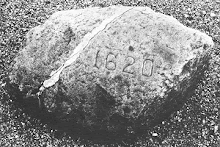
Plymouth Rock dated 1620
Plimoth Plantation
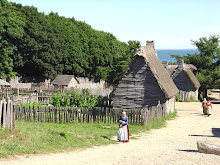
The Village
Plimoth Plantation

A Keeping Room
